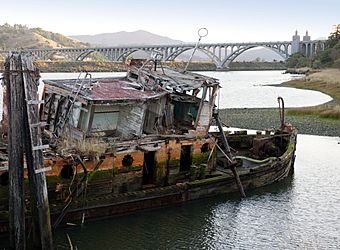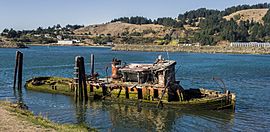Mary D. Hume (steamer) facts for kids
Quick facts for kids |
|
|
Mary D. Hume
|
|

Mary D. Hume and Isaac Lee Patterson Bridge
|
|
| Location | Port of Gold Beach, Gold Beach, Oregon |
|---|---|
| Built | 1880 |
| NRHP reference No. | 79002052 |
| Added to NRHP | August 01, 1979 |
The Mary D. Hume was a famous steamer built in 1881. She was built in Gold Beach, Oregon, which was then called Ellensburg. A businessman named R. D. Hume built her. The Hume had a very long and busy life. She carried goods, hunted whales in Alaska, and worked for fish canneries. Later, she became a powerful tugboat. After many years, she retired in 1977 and came back to Gold Beach. In 1985, she sank in the Rogue River. Today, her remains can still be seen on the riverbank. The Mary D. Hume is an important part of history. She is listed on the National Register of Historic Places.
Contents
Building the Mary D. Hume
The Mary D. Hume was built using local wood from Gold Beach. Her main support beam, called the keel, was huge. It measured 10 inches (25 cm) by 36 inches (91 cm) and was 140 feet (43 m) long. People said it was the "largest stick of square timber ever floated down Rogue River."
The ship's strong curved pieces, called knees, were cut by hand. They came from the roots of local Port Orford cedar trees. The wooden planks of the ship were held together with wooden pegs. Some of her machinery came from another ship, the Varuna, which had been wrecked.
The Hume weighed 150 tons. She was 96 feet (29 m) long, 22 feet (6.7 m) wide (beam), and had a 9 feet (2.7 m) draft. This means how deep she sat in the water. When she was first built, she had sails like a schooner.
A Long and Busy Life at Sea
R. D. Hume was a smart businessman in Wedderburn and Gold Beach. In 1881, he built the Mary D. Hume to help his fish cannery business. The Mary D. Hume was owned by several different companies over the years. She also had many changes and repairs. She was one of the oldest working commercial ships on the West Coast until the 1970s.
Early Years: Hauling Cargo
For her first eight years, the Hume carried goods. She traveled between San Francisco and Gold Beach. This helped connect the small town to bigger cities.
Whaling in the Arctic
In 1889, the Pacific Steam Whaling Company bought the Hume. They wanted to use her to hunt whales in the Arctic. To do this, her sails were changed to those of a brigantine.
Her first whaling trip was from 1890 to 1892. On this trip, she caught 37 whales. The cargo from these whales was worth $400,000! Her second whaling trip lasted even longer, from 1893 to 1899. During this time, new crews were sent to meet her in Herschel, Canada.
Working for Canneries and as a Tugboat
In 1900, the Hume started working for the Northwest Fisheries Company. She became a ship that helped fish canneries in Alaska. Between 1900 and 1904, she got a new steam engine. After sinking in ice in the Nushagak River, she was fixed in Seattle.
Around 1906 or 1908, she began working as a tugboat. She joined the American Tug Boat Company in Everett, Washington. She pulled logs and barges on Puget Sound. Her top structure was changed at this time. In 1939, she got a third new engine. This engine came from an old lightship on the Columbia River.
In 1954, a powerful 600-horsepower diesel engine was put in. Her top structure was changed again to how it looks today. In 1973, the Crowley Maritime Corporation bought the Hume. She continued to work as a tugboat. Finally, she retired in 1977. Crowley fixed her up in 1978 before sending her back to Gold Beach.
The Mary D. Hume Today
There was a plan to save the Mary D. Hume and turn her into a museum ship. However, during repairs, she accidentally slid off her support. She sank into the mud at Gold Beach. Also, a legal problem about who owned the ship caused the group trying to save her to lose their money.
Even though she sank, the Mary D. Hume is still on the National Register of Historic Places. You can still see her remains in Gold Beach today.
The Hume was added to the National Register of Historic Places on August 1, 1979. At that time, she was still floating on the Rogue River. Repairs started in 1985, but the accident caused her to sink. People tried to check on her and raise her, but there was no money to do it. In 1992, her status on the National Register was reviewed. The review decided that her hull was still important, so she stayed on the list.




